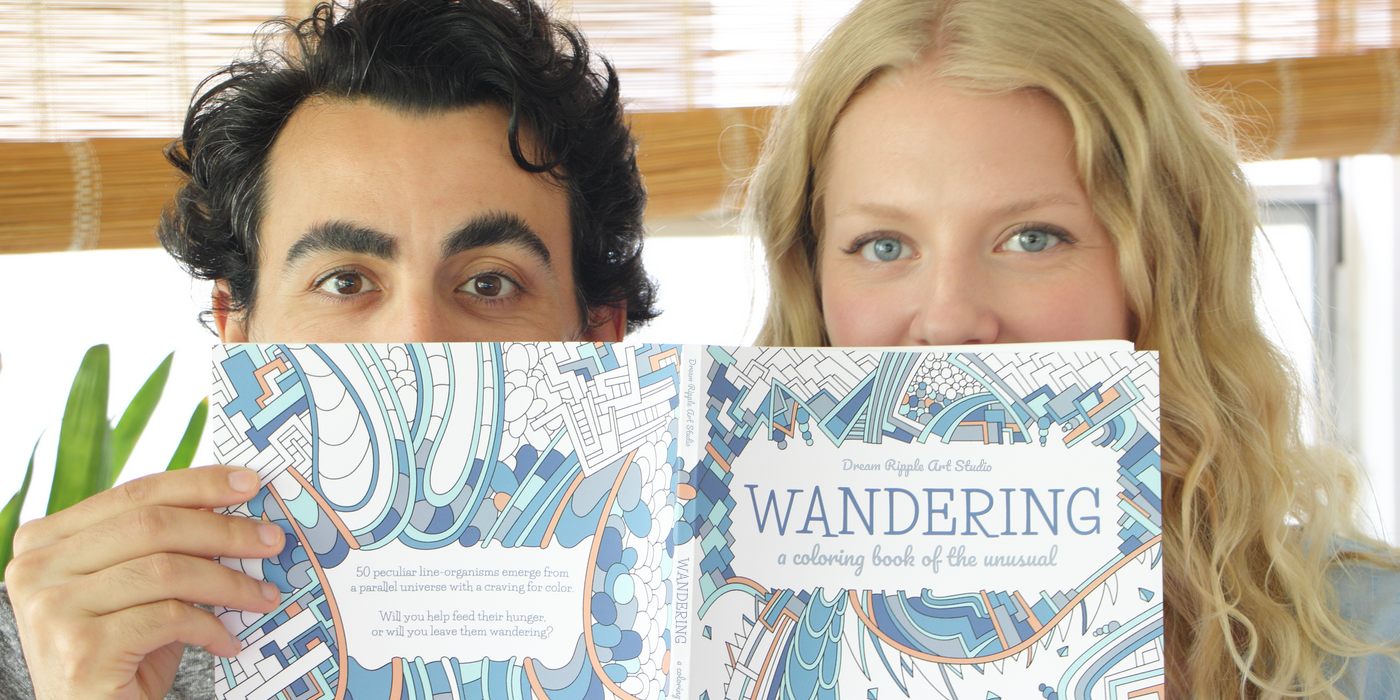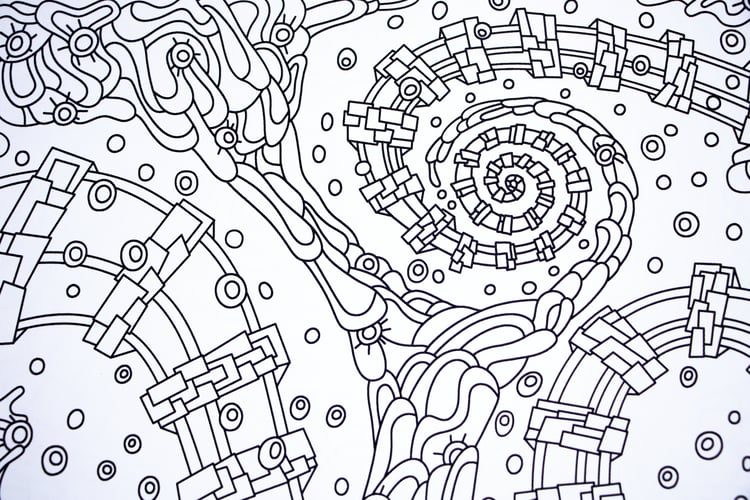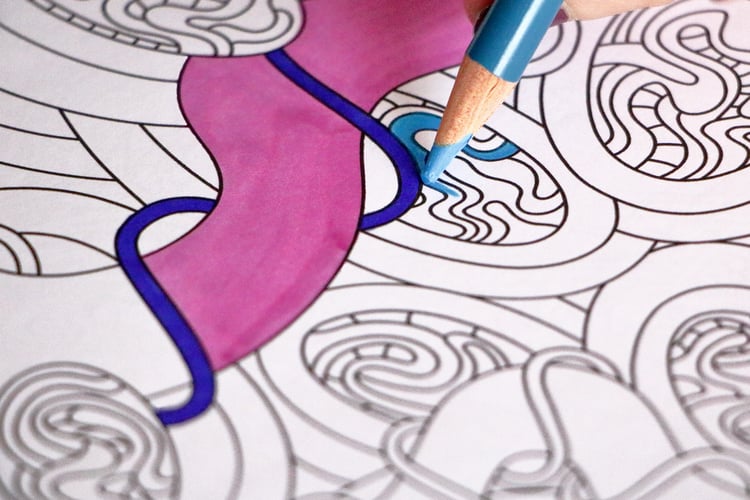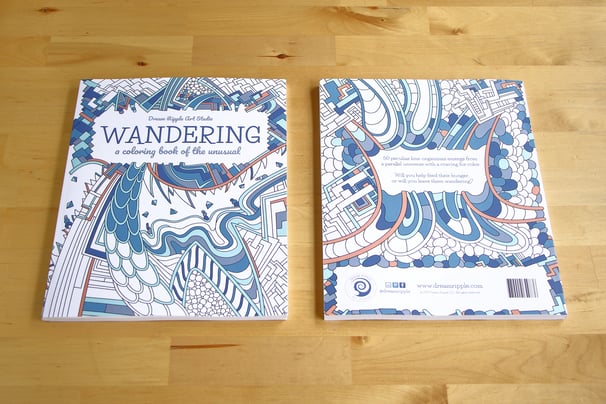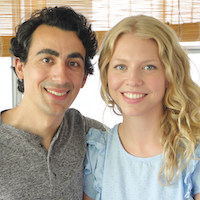Coloring books are a great way to relieve stress, have fun, and create a shared creative experience between the customer & artist. Behind the scenes of what goes into creating one is an art form itself, and we’re excited to share our experience. We hope to inspire future indie artists to bring their imagination to life and create that shared experience with others. Here’s our journey in creating Wandering: a coloring book of the unusual!
Inspiration
We formed Dream Ripple to create artwork with the hope to inspire curiosity in others. For a long time, Joe had been experimenting with an unusual abstract line style for doodles, fun drawings, & cards. After wandering through a craft store together, we got really inspired by how creative & fun coloring books were and it motivated us to try and create one!
Going into this, we wanted to see what we could do on our own, challenging ourselves to create something driven by our own motivation. We were inspired by so many fantastic artists and wanted to contribute our own voice. Immediately, we learned that a lot of questions needed to be answered: how to form a business, book formatting, economics, quality, market placement, customer experience, etc.
With that, we started our research.
Coloring Book Research
We observed a lot of coloring books on the market and ones we already owned. We tried to think critically about the customer experience and the main things we felt the customer would appreciate in a coloring book, including:
- Illustrations printed single-sided
- Option to cut out the illustration for framing
- Thick enough paper to handle at least the main color utensils
- Affordability for the customer
- Fair royalty compensation
And so with a general plan, Joe started sketching.
Visual Design
Visually, we really wanted to offer something unique. This seemed like the perfect opportunity for Joe to take an experimental abstract style he’d been obsessing over and apply it to a market and see what happens.
It was important to remind ourselves, “If the visual doesn’t pull us in at first glance, then it needs to be reworked.”
If the two of us found the visual design exciting, chances are someone else would, and the same goes for if we didn’t feel engaged by the imagery.
Every evening, Joe would pencil sketch on graph paper with the focus of each session being a sort of art therapy, letting his mind wander to organically hand-draw the designs. Early on, we decided that we needed at least 50 designs to offer customers enough variety & content to color; we also found 50 was a good average number compared to other coloring books. After Joe sketched one or two a night for about 2 months, the unusual line-organisms had emerged.
We took a broad stroke approach to this, we wanted to get everything done in a short period of time for consistency and faster evaluation as a whole.
Once all 50 line-organisms were sketched out, we transitioned into a design & quality refinement process.
Production & Refinement
This by far took us the longest. We scanned the pages into the computer to clean up the hand-drawn sketches inside of an open-source digital painting program called Krita. It was important for us to have the sketches appear clean but yet still feel organic. We experimented with line-thickness and ultimately decided that a consistent line thickness felt best for the visual style and for coloring. The sketches themselves were overhauled quite a bit from the initial concept, and some were completely changed from the original as we felt they were too detailed or didn’t have enough breathing room. It was challenging at times to make sure everything still felt consistent and functional for coloring.
Having both of us involved in separate roles really helped develop a strong quality check for the illustrations. Although Joe initially started the design process, Kayla’s fresh perspective during reviews allowed for us to catch mistakes and improve upon the base designs. Specifically, our process involved Joe printing out the images, Kayla using a red pen to markup design change suggestions, discussing it, Joe going back to fix it, print it out, and repeat until we were happy with the result.
In addition to the blank line art, both of us digitally colored in each of the 50 line-organism illustrations that we would later list for sale as art prints.
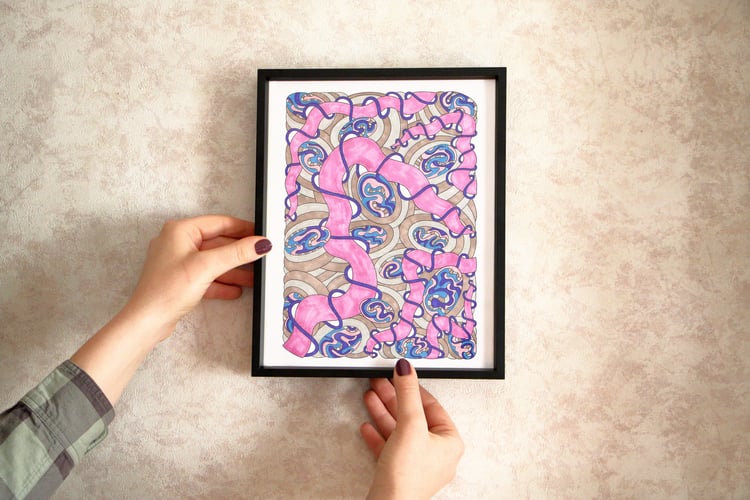 We created 4 color schemes per illustration which allowed us to do a last minute check to make sure the line art held up once colored. The process was tedious but it gave us another level of quality control. Sure enough, we found a lot of flaws in the illustrations that needed to be adjusted since coloring brings out the overall shape to the illustration.
We created 4 color schemes per illustration which allowed us to do a last minute check to make sure the line art held up once colored. The process was tedious but it gave us another level of quality control. Sure enough, we found a lot of flaws in the illustrations that needed to be adjusted since coloring brings out the overall shape to the illustration.
Alongside this refinement process, we ordered print tests of various paper types to see what worked best for coloring. We eventually went with 70 lb standard color paper, as we found that had struck a good balance between quality & budget.
With all of the art & product quality done, it was time to move onto the launch.
Art Studio & Product Launch
July 6, 2019, was the date we officially chose. We planned it to be finished with the artwork 3 months in advance of the official launch. Aside from the book release, we were launching an Art Studio and everything had to work together. Along the way, we had already started claiming social media accounts, started building a website, shot product photography, and overall set up a framework to fill in information later.
We did a soft-launch with the coloring book and enabled it for pre-order without making an official announcement. We also submitted the artwork to the Copyright Office. We learned this is not entirely necessary since you automatically own the copyright to your work, however, it provides extra legal protection.
Marketing a Coloring Book
This area is a bit of an uncertain one for us and we’re still very early on in this process. Being a startup company that self-published and licensed its artwork for the first time, how people will respond is still unknown. One thing that was tricky for us is that we didn’t want to reveal anything until after the book launched. We understand that gathering reviews during the pre-order process is important, as are reviews in general, but since this is our first product and we are a new company, we decided to focus on that after we got the book out on the market and see what happens. For future projects, we may decide to look into reviews before the pre-order process.
When we started, we knew this project would obviously be for people who like to color, but we didn’t worry about a specific target audience. Instead our thinking was to let it play out organically by associating the artwork with keywords based on our own perception. Once the designs were more refined, we wrote down how we felt about the line-organisms as a whole: abstract, surreal, strange, unusual, peculiar, etc. The project name, Wandering, along with the backstory was also decided this way and those keywords are used in social media posts & listing descriptions. While we hope that people find it through a similar interest, we are really curious how other people interpret the imagery!
Right now, we feel the best thing we can do is to create as much brand awareness as we can on the internet and talk about it in person. We’ve also experimented with running Instagram ads and Google Keyword ads, with the former yielding more results in terms of exposure to our brand (most likely because Instagram is so visual and can effectively grab the attention of an audience).
Similar to how self-publishing companies help authors & artists alleviate the stress of figuring out manufacturing, customer service, and market placement, we feel that internet ads & social media posts have the potential to reach a wider audience quicker & more effectively compared to showcase events, art fairs, book conventions, etc, due to the global & immediate connection of the internet. Road show type events may be effective, but we also have to be realistic about our time & budget limits.
Social media posting & internet ads are quick to make, freeing up additional time for creating more artwork and planning vacations.
While we are still learning a lot about marketing, we feel that our main goal right now is to keep experimenting to get the artwork in front of the right audience.
Conclusion
While the inspiration to create a coloring book was exhilarating, we found it was equally important to take a step back and observe how things work to make sure we didn’t fool ourselves into thinking it would happen overnight. Researching, experimenting, learning from mistakes, taking breaks, not rushing, and being self-critical on every step of the process allowed us to gradually reveal an end result that has left us feeling accomplished. After nearly 3 years, not only did we contribute something to the industry, but we felt the process taught us a lot about ourselves too. We look forward to learning more!
We hope that our journey of creating Wandering can help you in your own journey to make something authentic & unique. Thanks for reading!

